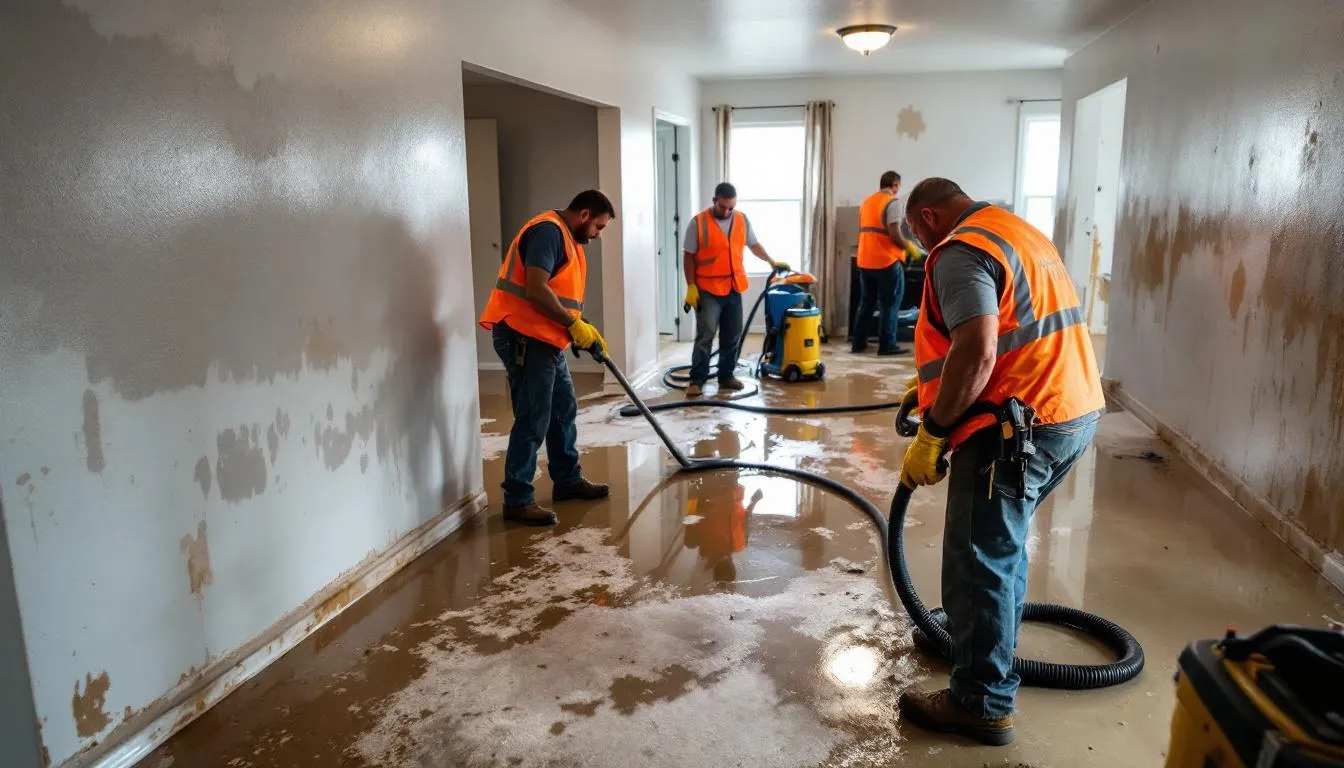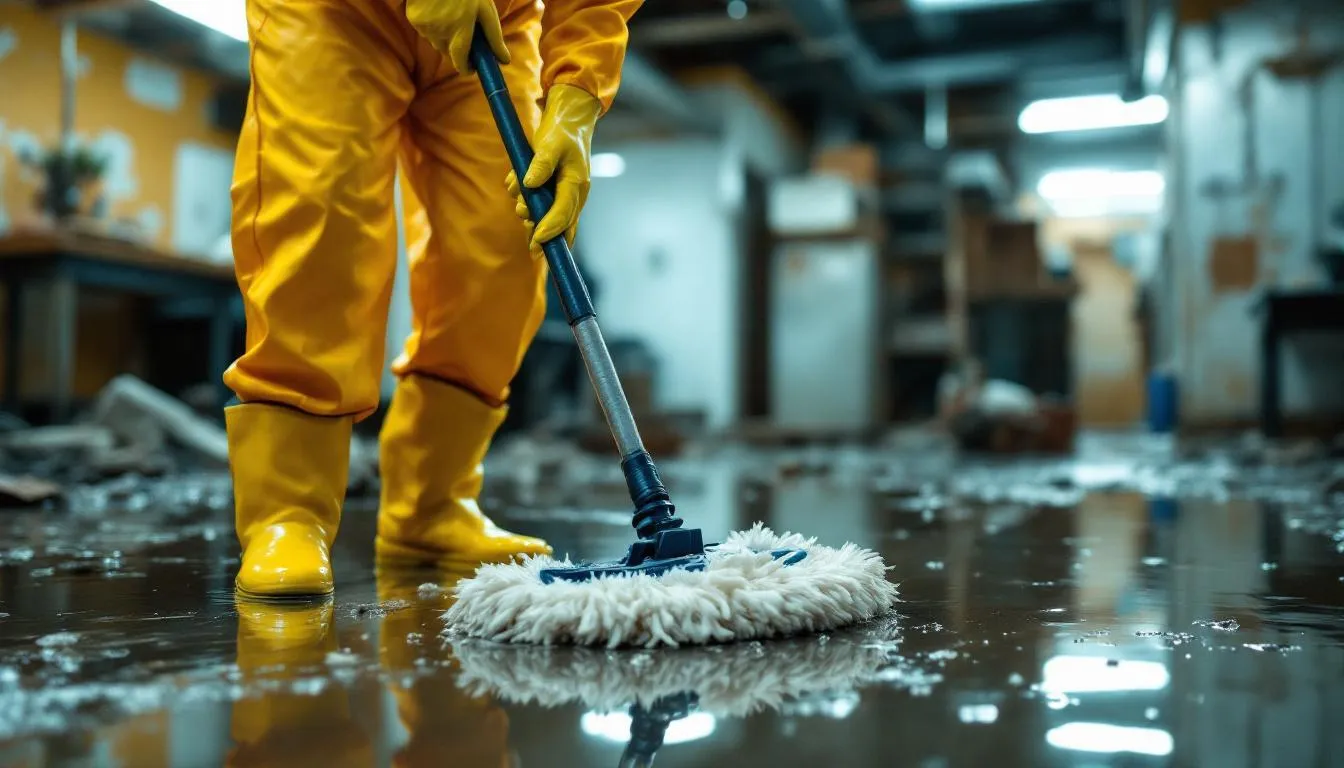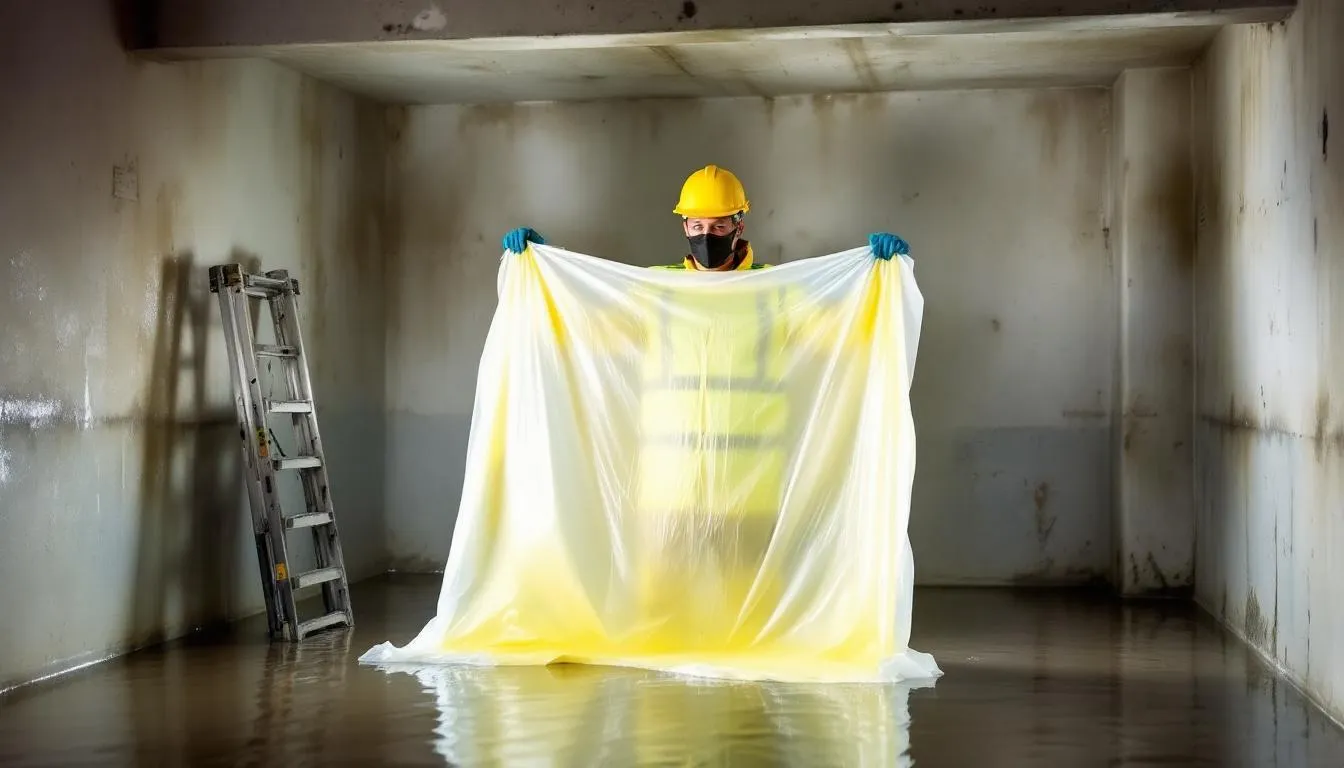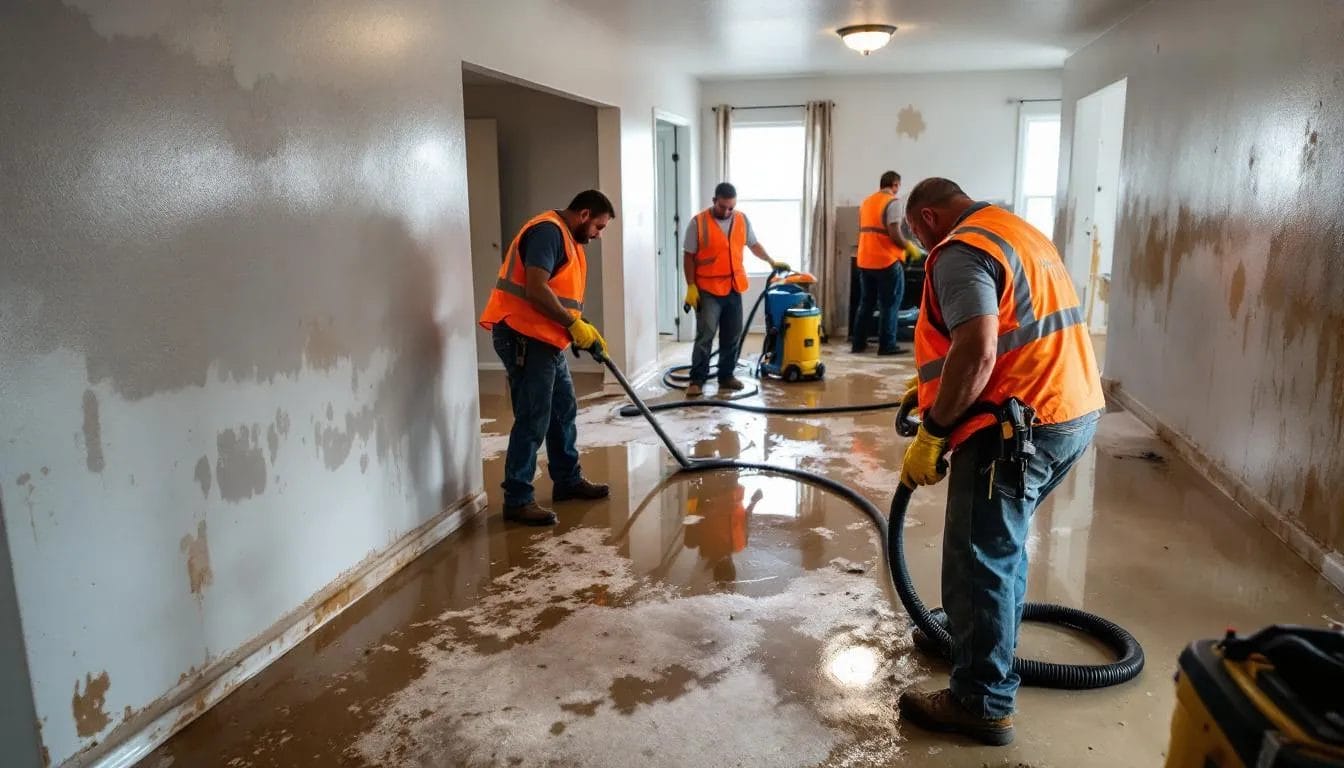
When flood waters recede from your home, you’re facing more than just a mess—you’re in a race against time. The first 48 hours after flooding are critical for preventing mold growth, structural damage, and serious health risks. Without proper flood cleanup techniques, what starts as water damage can quickly escalate into a months-long restoration nightmare involving hazardous materials and costly repairs. Improper or delayed cleanup can result in further damage to your property and health, including ongoing mold growth, structural deterioration, and increased health hazards.
This comprehensive guide will walk you through every step of safe flood cleanup, from essential protective gear to professional restoration decisions. Whether you’re dealing with a burst pipe, natural disaster flooding, or fire damage restoration, these proven strategies will help you protect your family’s health while salvaging as much of your property as possible.
Table of Contents
Key Takeaways
Before diving into the detailed cleanup process, understand these critical principles that can make the difference between successful recovery and ongoing problems:
- Begin flood cleanup within 24-48 hours to prevent mold growth and further contamination. Delays dramatically increase health risks and restoration costs.
- Protecting yourself is essential: Wear protective gear including N-95 respirators, waterproof boots, rubber gloves, and safety goggles during all cleanup activities. Follow safety protocols to safeguard your health from hazards like mold, asbestos, and contaminated water.
- Sort materials immediately – discard water-damaged absorbent items like carpets and drywall, while cleaning and drying non-absorbent materials like metal and glass.
- Use detergent and water first, then EPA-registered disinfectants on clean, non-absorbent surfaces. Never mix bleach with other chemicals or cleaning products.
- Ensure complete drying using fans, dehumidifiers, and moisture meter readings before reconstruction. Hidden moisture creates ongoing mold and structural problems.
- Contact insurance within 24 hours and consider hiring certified professionals for extensive damage, sewage contamination, or when family members have health conditions.
- Valuable resources and additional resources for flood cleanup, safety, and disposal procedures are available from organizations like the EPA, CDC, and HUD. These resources provide authoritative guidance and practical instructions for protecting your health and property.

Essential Safety Precautions During Flood Cleanup
Flood cleanup poses serious health risks that many homeowners underestimate. The water that invaded your home isn’t just dirty—it’s a cocktail of harmful substances including sewage, chemicals, bacteria, and debris that can cause immediate illness and long-term health problems.
High-risk individuals should avoid flood damaged areas entirely. People with asthma, compromised immune systems, children, pregnant individuals, and elderly family members face heightened risks from exposure to contaminants and should stay away from affected areas until professional cleaning is complete.
Flood water and standing water often contain sewage bacteria like E. coli and Salmonella, industrial chemicals, pesticides, and other hazardous materials washed from surrounding areas. In older buildings, the flooding may have disturbed asbestos-containing materials or lead paint, requiring specialized handling procedures that go far beyond typical cleanup methods.
Never take shortcuts with chemical safety. One of the most dangerous mistakes is mixing cleaning products. Never mix bleach with ammonia or other unknown chemicals, as this creates toxic chlorine gas that can cause severe respiratory damage or death. Always use cleaning products individually and ensure proper ventilation.
Watch for health warning signs during cleanup. Consult healthcare providers immediately if anyone experiences persistent coughing, breathing difficulties, skin rashes, or other respiratory issues during the cleanup process. These symptoms may indicate dangerous exposure levels that require medical intervention.
Washing hands and any exposed skin thoroughly after contact with flood water or contaminated materials is essential to reduce the risk of infection and maintain proper hygiene during cleanup.
Required Protective Equipment

Personal protective equipment isn’t optional—it’s essential for every person involved in flood cleanup. The right protective gear creates a barrier between you and the dangerous contaminants present throughout flood damaged areas.
Essential protective clothing includes:
- N-95 respirator masks (minimum) to filter airborne contaminants, mold spores, and fine particulate matter
- Waterproof boots with slip-resistant soles to protect feet from contaminated water and sharp debris
- Heavy-duty rubber gloves that extend past the wrists for hand and forearm protection
- Safety goggles to shield eyes from chemical splashes and airborne debris
- Long sleeved shirt and long pants to minimize skin exposure to contaminated surfaces
- Face shields when working with strong disinfectants or in heavily contaminated areas
Inspect all protective gear before each use. Damaged gloves, cracked goggles, or worn work shoes compromise your protection and should be replaced immediately. Remember that protective gloves and other protective clothing must be properly disposed of after use to prevent spreading contaminants to clean areas of your house.
Immediate Response: First 24-48 Hours

The initial hours after flooding determine whether your cleanup will be manageable or spiral into a major restoration project. Swift action during this critical window prevents secondary damage and reduces both health risks and costs.
Contact your insurance company within 24 hours to report the damage and begin the claims process. Many policies have strict notification requirements, and delays can affect your coverage. Before touching anything, thoroughly document all damage with photographs and video for insurance purposes—this documentation becomes crucial for claim approval and reimbursement.
Remove standing water immediately using wet/dry vacuums, pumps, or professional water extraction equipment. The longer water sits, the deeper it penetrates into building materials like drywall, insulation, and structural wood. For large volumes of water, industrial pumps may be necessary, but ensure all electrical hazards have been addressed before operating equipment.
Maximize air circulation by opening doors, windows, cabinets, and drawers throughout affected areas. This promotes evaporation and prevents moisture from becoming trapped in enclosed spaces where mold thrives. Remove waterlogged materials that cannot be thoroughly cleaned or dried, including saturated carpeting, padding, and damaged drywall. When cleaning surfaces and removing contaminants, using warm water—if available—can improve the effectiveness of cleaning and help remove dirt, grime, and other contaminants more thoroughly.
Professional vs. DIY Assessment
Determining whether to handle flood cleanup yourself or hire professionals depends on several critical factors beyond just cost considerations.
DIY cleanup may be appropriate for:
- Minor flooding from clean water sources (broken pipes, appliance leaks)
- Small affected areas (single room or basement section)
- No electrical system exposure or structural damage
- Household members without health vulnerabilities
Professional intervention is essential for:
- Extensive flooding covering multiple rooms or entire floors
- Sewage contamination or exposure to hazardous materials
- Structural damage or compromised building materials
- Electrical system exposure requiring specialized safety protocols
- HVAC system contamination needing specialized cleaning
When hiring professionals, verify their qualifications carefully. Look for certifications from recognized organizations like IICRC (Institute of Inspection, Cleaning and Restoration Certification), proper licensing for mold removal and water damage restoration, and current insurance coverage. Check references from recent projects and obtain multiple estimates to ensure fair pricing.
Material Sorting and Salvage Decisions
One of the most difficult aspects of flood cleanup involves deciding what can be saved versus what must be discarded. These decisions affect both your safety and your insurance claim, making careful evaluation essential.
Discard all absorbent materials that cannot be thoroughly cleaned and dried. Materials that absorb water, such as carpeting and padding, upholstered furniture, mattresses, pillows, drywall that was submerged, and insulation materials, are difficult or impossible to disinfect thoroughly. These items can harbor bacteria and mold even after apparent cleaning, creating ongoing health risks.
Non-absorbent items often can be saved through proper cleaning and disinfection. Metal furniture, glass items, ceramic dishes, sealed wood furniture, and hard plastic items typically survive flood cleanup when handled correctly. However, even salvageable items require thorough cleaning with detergent followed by disinfection.
Electronics and appliances require special evaluation. Never attempt to power on electrical items that were exposed to flood waters until they’ve been professionally inspected. Water damage can create hidden electrical hazards that aren’t immediately visible but can cause fires or electrocution.
Document everything before disposal. Photograph valuable items in their damaged state for insurance purposes, and keep receipts for any disposal costs. Hazardous household materials like paint, pesticides, and certain cleaning products require special disposal procedures—never place these in regular trash.
Textile and Fabric Evaluation
Clothing and fabric items require careful assessment based on their material, construction, and level of contamination exposure.
Machine-washable fabrics may be salvageable if laundered immediately in hot water with appropriate disinfectants. Use the hottest water setting safe for the fabric and add bleach if the material can tolerate it. Run items through multiple wash cycles if necessary to ensure complete cleaning.
Dry-clean-only items should be taken to professional cleaners immediately, but inform them about the flood exposure. Many dry cleaners have experience with flood-damaged items and can determine if cleaning is possible.
Items that typically cannot be saved include stuffed animals and soft toys that cannot withstand disinfection, pillows and comforters exposed to contaminated water, and leather goods that require specialized cleaning beyond typical household capabilities.
For valuable items like family heirlooms or expensive clothing, consider professional restoration services even if the cost seems high initially. Sometimes specialized cleaning can save items that appear beyond hope.
Proper Cleaning Techniques and Products
Effective flood cleanup requires a systematic approach that removes contaminants without spreading them to clean areas. The wrong techniques can actually make contamination worse by stirring harmful substances into the air or pushing them deeper into materials.
Always clean surfaces before disinfecting. This two-step process is crucial because dirt, debris, and organic matter can protect bacteria and viruses from disinfectants, rendering them ineffective. Start by cleaning surfaces with detergent and clean water to physically remove contamination. If you plan to use bleach as a disinfectant, do not mix it with other products during the cleaning process, as this can create dangerous reactions.
Use wet cleaning methods rather than dry sweeping or dusting, which can disperse contaminants into the air where they’re easily inhaled. Damp cloths, mops, and wet/dry vacuums contain particles rather than spreading them around.
Work systematically from top to bottom to avoid recontaminating previously cleaned areas. Clean higher surfaces like countertops and shelves before tackling floors, and move from cleaner areas toward more heavily contaminated zones.
Clean water is essential throughout the process. Change cleaning water frequently as it becomes dirty, and never use contaminated water to clean surfaces. If your regular water supply is compromised, use bottled water for cleaning solutions.
Disinfectant Application Guidelines
Proper disinfection kills dangerous microorganisms but only works when applied correctly to clean surfaces.
Bleach solutions remain the gold standard for flood cleanup disinfection. Mix 1 cup of bleach per gallon of water for most surfaces, but always follow manufacturer instructions for specific products. The solution must remain in contact with surfaces for the recommended dwell time—typically 5-10 minutes—to be effective.
Never use disinfectants on absorbent materials like unfinished wood, fabric, or drywall. These materials cannot be adequately disinfected and should be discarded if contaminated. Focus disinfection efforts on hard surfaces like countertops, appliances, and sealed flooring.
Ensure adequate ventilation when using any cleaning product, especially those containing bleach or other strong chemicals. Open windows and use fans to prevent vapor buildup that can cause respiratory irritation. Never add bleach to other cleaning products or mix different disinfectants together.
Follow contact time requirements specified on product labels. Many people apply disinfectants and immediately wipe them away, which doesn’t allow enough time to kill microorganisms effectively.
Complete Drying Process
Thorough drying is perhaps the most critical aspect of flood cleanup, yet it’s often rushed or inadequately completed. Hidden moisture creates ongoing problems that can surface weeks or months after the initial flooding.
Use moisture meter readings to verify drying progress rather than relying on visual assessment or touch. Professional-grade moisture meters can detect dampness inside walls, under flooring, and in other hidden areas where problems develop. Aim for moisture levels of 15% or less in building materials before proceeding with repairs.
Remove built-in components to expose hidden wet surfaces. This often means taking out baseboards, cabinet drawers, shelves, and sometimes portions of drywall to access areas where moisture accumulates. These hidden pockets can sustain mold and mildew growth for months if not properly dried.
Run drying equipment continuously for as long as necessary—typically several days to weeks depending on the extent of flooding and local humidity levels. Industrial fans, dehumidifiers, and sometimes heaters work together to remove moisture from both the air and materials.
Monitor progress daily by checking moisture meter readings and adjusting equipment placement as needed. Areas that seem dry may still contain dangerous moisture levels that require continued attention.
HVAC System Considerations
Your heating and cooling system can either help or hinder the drying process, depending on its condition and how you use it during cleanup.
Never operate contaminated HVAC systems until they’ve been professionally inspected and cleared. Systems exposed to flood water can distribute contaminants and mold spores throughout your entire house, making localized cleanup efforts ineffective.
Have air ducts professionally cleaned if there’s any possibility of contamination. Even systems that weren’t directly flooded may have drawn in contaminated air during the flooding event.
Replace all air filters after flood cleanup is complete, and use high-efficiency filters during the restoration process if the system is safe to operate. This helps remove airborne particles and improves air quality during cleanup.
Use HVAC systems strategically to assist drying, but only after initial mold cleaning is complete. Running contaminated systems before cleanup can spread mold spores to previously unaffected areas of your home.
Essential Flood Cleanup Tools and Equipment
Having the right tools makes flood cleanup safer, more efficient, and more thorough. Some equipment is essential for any cleanup, while other items may be necessary depending on the scope of damage.
Basic cleanup tools include:
- Wet/dry vacuums with large tank capacity for water extraction and debris removal
- Heavy-duty trash bags for disposing of contaminated materials safely
- Squeegees and industrial mops for removing residual moisture from hard surfaces
- Shovels and buckets for mud and debris removal, especially in basements and crawl spaces
- Portable generators to power equipment when electrical service is disrupted
Cleaning supplies you’ll need:
- Scrub brushes, sponges, and microfiber cloths for detailed surface cleaning
- Multiple cleaning products designed for different surfaces and contamination types
- Plenty of clean water for mixing solutions and rinsing
- Protective plastic sheeting to isolate clean areas from contaminated zones
Specialized Equipment for Effective Cleanup
Professional-grade equipment dramatically improves cleanup effectiveness but may require rental or professional services.
Industrial dehumidifiers and high-velocity fans remove moisture much faster than household equipment. These powerful units can handle the large volumes of water vapor released during structural drying.
Moisture meters and humidity monitors provide objective measurements that guide decision-making. These tools help determine when materials are truly dry and safe for reconstruction.
Submersible pumps handle large volumes of standing water much more efficiently than shop vacuums, especially in basements or areas with significant flooding.
Air filtration systems with HEPA filters help clean the air during cleanup, reducing health risks and improving working conditions.
Health Monitoring and Medical Considerations
Flood cleanup takes a physical toll, and exposure to contaminants can cause both immediate and delayed health effects. Staying alert to health changes protects everyone involved in the cleanup process.
Monitor for respiratory symptoms including persistent coughing, shortness of breath, chest tightness, or unusual fatigue. Mold exposure can cause allergic reactions, irritant effects, and in some cases, serious respiratory infections.
Watch for skin problems like rashes, irritation, or infections, especially around cuts or scrapes. Contaminated flood water can introduce bacteria through even minor skin breaks.
Seek immediate medical attention for severe symptoms including difficulty breathing, chest pain, severe allergic reactions, or signs of infection. Don’t wait to see if symptoms improve on their own.
Document health issues that develop during or after cleanup. This information may be important for insurance claims, workers’ compensation, or ongoing medical care.
Consider tetanus vaccination if anyone involved in cleanup hasn’t had a recent booster, especially if there have been cuts or puncture wounds from debris.
Insurance and Documentation Requirements
Proper documentation protects your financial recovery and ensures you receive fair compensation for flood damage and cleanup costs.
Photograph everything before cleanup begins – damaged areas, standing water, affected belongings, and structural issues. Take both wide shots showing overall damage and close-ups of specific problems.
Keep detailed records of all cleanup activities, including dates, times, people involved, and work completed. This creates a timeline that insurance adjusters find valuable.
Save all receipts for cleanup supplies, equipment rentals, professional services, and temporary housing if needed. Even small expenses add up and may be reimbursable.
Work closely with insurance adjusters to understand your coverage limits, claim procedures, and documentation requirements. Many policies have specific requirements for professional versus DIY cleanup that affect coverage.
Obtain multiple estimates for professional restoration work if required by your insurance policy. This helps ensure fair pricing and provides options for different approaches to repairs.
Frequently Asked Questions
How quickly does mold grow after flooding?
Mold can begin growing within 24-48 hours on wet organic materials like wood, drywall, and carpet. Higher temperatures and humidity accelerate this process significantly, which is why immediate action is crucial. Visible mold colonies typically appear within 7-10 days under ideal conditions, but microscopic growth starts much earlier and can cause health problems even before it’s visible.
Can I save furniture and appliances after flood damage?
Non-absorbent furniture made of metal, plastic, or sealed wood can often be cleaned and disinfected successfully. However, upholstered furniture, mattresses, and items with fabric components typically cannot be adequately cleaned and should be discarded. Electronics and appliances require professional evaluation before attempting to restore power, as water damage can create hidden electrical hazards that aren’t immediately apparent.
When should I hire professional flood cleanup services?
Professional services are essential for extensive flooding covering large areas or multiple rooms, any sewage contamination or exposure to hazardous materials, structural damage or electrical system exposure, and when household members have health conditions that make DIY cleanup dangerous. Also consider professionals when HVAC systems are contaminated or when the scope of work exceeds your available time and energy.
How long does the complete flood cleanup process take?
Initial water removal and basic cleanup typically takes 3-7 days for moderate flooding, but this varies significantly based on the extent of damage. The complete drying process can require 1-4 weeks depending on materials affected, weather conditions, and equipment used. Full reconstruction and restoration may take several weeks to months for extensive damage. The timeline depends heavily on flood severity, home size, and whether you use professional services versus DIY approaches.
Successful flood cleanup requires patience, attention to safety, and recognition that rushing the process often creates bigger problems later. When in doubt, prioritize safety over speed, and don’t hesitate to seek professional help when the situation exceeds your capabilities or comfort level.


